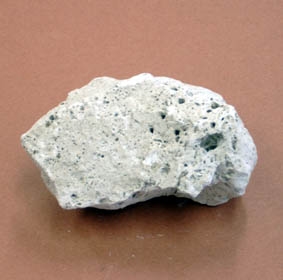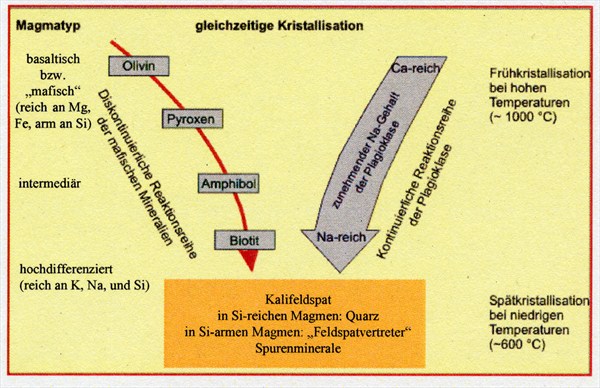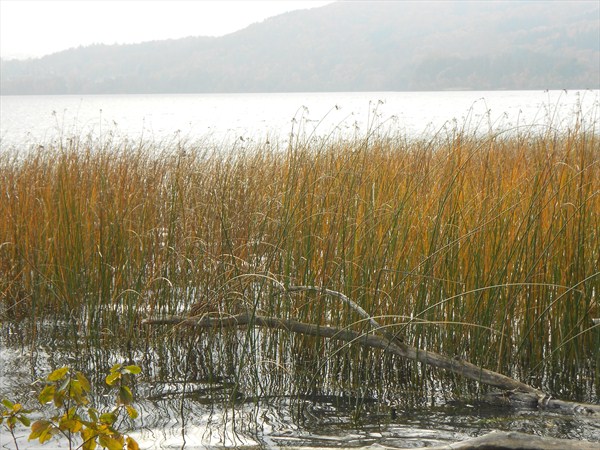Die Entstehung von Mineral- und Thermalwässern hier am Laacher See
geht auf den Vulkanismus der Eifel zurück. Bei Vulkanausbrüchen
treten Gase in größeren Mengen aus. Bei Temperaturen über 100 C
werden neben Wasserdampf Chlorwasserstoff (HCL), Schwefeldioxid,
Schwefelwasserstoff, Stickstoff und Kohlendioxid abgegeben. Bei
Temperaturen unter 100 C wird hauptsächlich Kohlendioxid
freigesetzt.

Eine Rauchwolke über dem Vulkan zeigt deutlich, dass viele dieser
Gase entströmen. Erfolgt diese Entgasung nicht durch einen offenen
Schlot, weil der Magmenkörper zu tief liegt bzw. die Schlote durch
Lava verstopft sind, strömt das freiwerdende Gas in das
Nebengestein des Herdes. Von hier aus steigen die Gase schließlich
auf Klüften und Verwerfungen an die Erdoberfläche und verbinden
sich mit dem Grundwasser. Dadurch wird das Wasser zum
Mineralwassser.
Vor fast 13.000 Jahren ereignete sich einer der letzten und
dramatischsten Ausbrüche, die nach der Entleerung der Magmakammer
zum Einbruch einer Caldera führte. Vulkankegel im Gebiet des
heutigen Sees explodierten, Lavafetzen und hochgejagtes
Lockermaterial (Lapilli, Aschen) bildeten bei ihrer Ablagerung am
Ringwall des Beckens bis zu 30 m hohe gebänderte Tuff-, Bims- und
Ascheschichten. Bimsstein, ein vulkanisches Lockerprodukt, entsteht
aus gasreichen silikatischen Schmelzen, die als Magmafetzen bei
explosiven Eruptionen ausgeschleudert werden und durch die
entweichenden Gase zu glasigen, aufgeblähten, porösen Aggregaten
(natürliches Schaumglas) erstarren. Bimsstein ist extrem leicht,
sogar auf Wasser schwimmfähig.

Bei diesem Vorgang werden mit abnehmender Temperatur aus dem Magma
jeweils unterschiedliche Minerale gebildet und so die
Zusammensetzung der Restschmelze verändert - magmatische
Differentiation - (siehe Skizze). Die „diskontinuierliche
Reaktionsreihe“ zeigt die Folge der mafischen Mineralien
(dunkle Kristalle, da reich an Magnesium- und Eisenionen, Fe).
Dabei reagiert bei Abkühlung des Magmas die Restschmelze unter
Bildung des in der Reihe folgenden Minerals. Die
„kontinuierliche Reaktionsreihe“ zeigt die Bildung der
Plagioklase (Feldspäte) nach Art einer Mischkristallfolge, also
nicht unter Bildung eines anderen Minerals, solange, bis die
Schmelze aufgebraucht ist. Die Mineralabfolge dieser beiden Reihen
zeigt, dass der SiO2-Gehalt der Restschmelze mit zunehmender
Kristallisation steigt.

Beeindruckend sind die im See durch das entströmende Kohlendioxid
aufsteigenden Gasblasen. Diese sind am besten am Ostufer in einem
100 bis 200 Meter breiten Streifen zu sehen. An verschieden Stellen
am Westufer treten dagegen Sand- und Silitsteine des Unterdevons
zutage.
Nun zum Cache:
Beantworte bitte folgende Fragen und sende mir die Antworten über
mein Profil zu. Du kannst direkt nach der mail loggen und musst
nicht auf meine Logfreigabe warten. Sollte etwas nicht stimmen,
werde ich mich bei Dir melden. Es wäre schön, wenn Du ein Foto von
Dir bzw. Deinem GPS an den o.g. Koordinaten Deinem Log anhängen
würdest.
1. Wo versickert das an Talhängen austretende Wasser und wo fließt
es aus?
2. Wo liegen die meisten Kohlensäureaustritte?
3. Schätze die Entfernung von den Koordinaten zu dem auf der Wiese
gefassten Säuerling.
Ich hoffe, der Earthcache macht Euch viel Spaß.
English version:
The formation of mineral and thermal waters here at this lake goes
back to the volcanism of the Eifel, when gases from volcanic
eruptions occur in larger quantities. At temperatures above 100 C
in addition to water vapor, hydrogen chloride (HCl), sulfur
dioxide, hydrogen sulfide, nitrogen and carbon dioxide emitted. At
temperatures below 100 C its only carbon dioxide.

A cloud of smoke above the volcano clearly shows that many of these
gases escape. If they are not venting through an open vent, because
the magma is too deep or the vents blocked by lava, the released
gas flows into the country rock of the stove. From here the gases
eventually rise to fractures and dislocations to the surface and
combine with the groundwater. So the water becomes
Mineralwater.
Nearly 13,000 years occurred one of the last and most dramatic
outbursts, which led to the emptying of the magma chamber to
collapse of a caldera. Volcanic cones in the area of today's
exploding lake, lava and highly chased loose material (lapilli,
ash) were at their deposition on the ring wall of the pelvis up to
30 m high banded tuff, pumice and ash layers. Pumice, a volcanic
Locker product is formed from gas-rich silicate melts, which are
ejected during explosive eruptions as magma fragments and glassy by
the escaping gases, bloated, solidify porous aggregates (natural
foam glass). Pumice is extremely light, buoyant even in
water.

During this process different minerals are formed with decreasing
temperature of the magma and alter the composition of residual melt
- magmatic differentiation - (see picture). The "discontinuous
reaction series" shows the sequence of mafic minerals (dark
crystals, as rich in magnesium and iron ions, Fe). It reacts upon
cooling of the magma, the residual melt to form the following
series in the mineral. The "continuous reaction series" shows the
formation of plagioclase (feldspars) in the manner of a solid
solution series, not the formation of another mineral, until the
melt is depleted. The mineral sequence of these two series
indicates that the SiO2 content increases with increasing the
residual melt crystallization.

Impressive are the carbon dioxide flowing out of the lake by the
rising gas bubbles. These are best to see on the east bank in a 100
to 200 meter wide strip. Occur at different locations on the west
bank of sand and light contrast Silitstones of the lower
Devonian.
Now to the cache:
Please answer the following questions and send me the answers to my
profile. You can log this cache directly to the mail. If there is
something wrong, I will contact you. Please take a optional picture
of you or your GPS in front of the Infoboard and add it to your
log.
1. Where the water coming from the valley slopes seeps and where
does it go?
2 Where are the most carbonic acid exits?
3. Estimate the distance from the coordinates to the "Säuerling" on
the meadow.
I hope this Earthcache makes you a lot of fun.